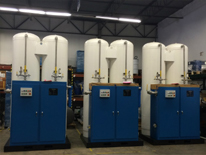Why Generate Your Own Nitrogen or Oxygen Gas?
 Various industries, hospitals, and businesses may feel like they have no other option than to get cryogenic gas delivered in bulk to meet their nitrogen and oxygen needs. But this is not the case. On Site Gas makes it possible for these facilities to generate their own nitrogen and oxygen by means of an O2 & N2 Site self-generating system. When compared to cryogenic gas, these systems offer a variety of advantages.
Various industries, hospitals, and businesses may feel like they have no other option than to get cryogenic gas delivered in bulk to meet their nitrogen and oxygen needs. But this is not the case. On Site Gas makes it possible for these facilities to generate their own nitrogen and oxygen by means of an O2 & N2 Site self-generating system. When compared to cryogenic gas, these systems offer a variety of advantages.
Advantages of O2 & N2 Self-Generating Gas Systems
Ease of Use
No contracts to sign, you can purchase, lease or rent nitrogen and oxygen generating systems.
Low Maintenance Costs – System Can Last for Decades
Regular maintenance helps our nitrogen and oxygen generators last for decades.
Portable
Many of the O2 & N2 Site systems offer portability. These systems can be used anywhere that electricity and air are available. These systems are even usable in harsh conditions and extreme climates.
Less Expensive Than Purchasing Cryogenic Gas
The O2 & N2 Site gas generating systems are economical. The typical cost per CCF of the self-generated gas systems ranges from one-third to one-half of the costs associated with purchasing cryogenic gas.
No More Concerns About Running Out of Gas
Any concerns related to running out of gas are eliminated because the O2 & N2 Site system generates its own gas.
Pressure Swing Adsorption (PSA) and Membrane Technologies – How They Work
The O2 & N2 Site systems have two ways of generating gas: membrane technology or PSA.
The Process of Pressure Swing Adsorption
That is adsorption, not absorption. These two words may look similar, but they mean two very different things. Adsorption differs from absorption in that absorption is a chemical process, whereas adsorption refers to the physical process of actually separating gas molecules from one another.
PSA systems are designed to generate both N2 and O2. Compressed air is used to pressurize a vessel that is filled with zeolite or carbon. Zeolite and carbon separate molecules according to their structure or physical composition.
The forcing of air into the vessel causes either the O2 or N2 molecules to become trapped; meanwhile, the other gas floats free. As pressure releases, the O2 or N2 molecules are drawn off and collected in the tank. The captured molecules of unwanted gases are released into the air via a pressure release valve. These unwanted gases immediately recombine into ambient percentages.
Our systems consist of two sieve beds working at opposing ends of the cycle. This ensures there is constantly a consistent flow of O2 or N2.
The N2 Membrane – How it Works
The membranes in our systems consist of a series of hollow fibers that have holes in their walls. These holes are small enough to allow O2 molecules to escape. These molecules escape when pressure within the fibers increases.
These holes are too small to allow N2 molecules to escape. Therefore, when air is forced down the fiber, the O2 molecules exit the fibers and the N2 molecules are captured in the fibers at the opposite end.
The air within the membranes is typically heated. Heating the air excites the molecules, which increases the chance that they will exit through the holes in the fiber.
Our Nitrogen and Oxygen Generating Systems Are Durable and Versatile
Our nitrogen and oxygen generating systems are used across essentially every conceivable place where these gases are needed. We build our N2 and O2 generator systems under the assumption that they need to operate for decades.
That is why our nitrogen and oxygen generating systems are used even in the most remote places on the planet, at numerous combinations of hertz and voltage as well as under the most extreme climates. In fact, our portable oxygen generators are saving the lives of military personnel, no matter where they are located.
If you want to learn more about the innovative products we offer, contact On-Site Gas Systems today.








